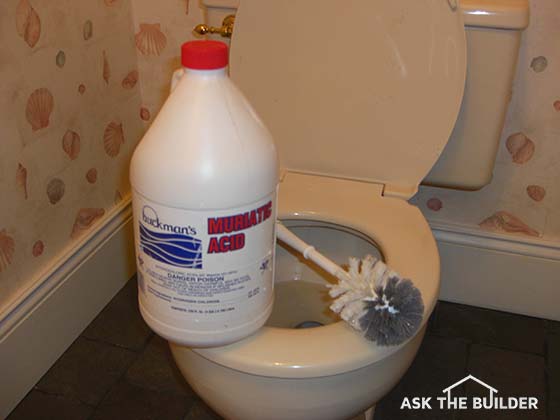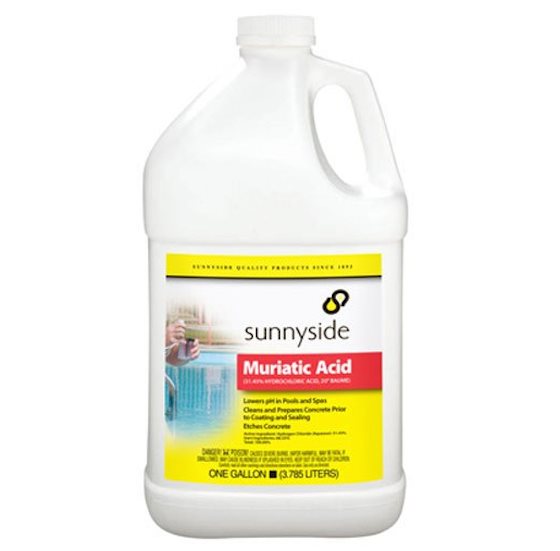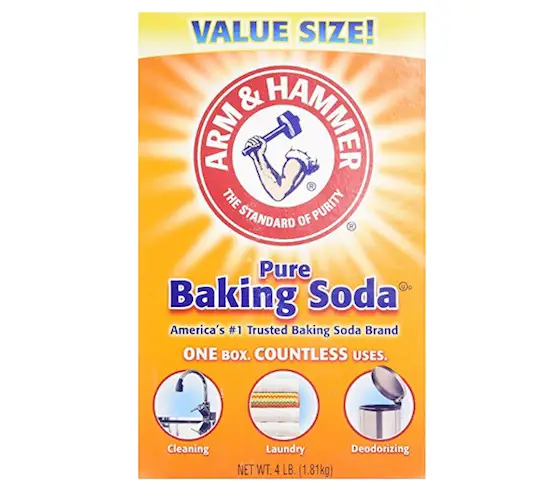Toilet Bowl Cleaner

The normal toilet bowl cleaners you get at the grocery often don’t have the power to really clean a toilet. You may need to use muriatic acid. ©2017 Tim Carter
Toilet Bowl Cleaner TIPS
- Normal cleaners don't clean tough stains
- Powerful acid is required
- DIY doable with care and safety
- Allow acid solution to work for hours
- CLICK HERE to Get Tim's FREE & FUNNY Newsletter!
DEAR TIM: I’m at my wits end with toilet bowl cleaners. My toilet has light and dark stains in the bottom of the bowl as well as up under the rim.
I’ve tried all of the national-brand the store-bought toilet bowl cleaners and even the automatic toilet bowl cleaners that fit on the rim of the bowl and stick to the bowl.
None of them do anything to cut the stains. What’s causing the stains and what, if anything, can I do to get my toilet looking respectable. It’s embarrassing and I’m about ready to rip it out and purchase a new toilet. Help me please. Amy H., Lexington, KY
This popular column was shared with all my readers in the April 3, 2015 AsktheBuilder Weekend Warrior.
DEAR AMY: Oh, I’ve been where you’re at. I remember years ago suffering trying to get a cleaner toilet bowl using all the different products at the grocery store as well as every type of brush and scrubbing pad known to man and woman.
I have clear memories of wearing rubber gloves and goggles trying to restore a deeply stained toilet in the basement of a past house I owned. Believe me, it didn't take long to get frustrated like you.
Tear-Pants Limestone
I got my toilets sparkling clean, but only after I stepped back and thought about some of the things I had discovered in my college chemistry and geology-lab classes.
Decades ago I was a geology student attending a six-week field course camp in the Tobacco Root Mountains of Montana. CLICK HERE to get a fantastic map of this gorgeous mountain region.

If you want to go hiking instead of cleaning your toilet, I don't blame you. Use this great book to wander across trails I walked while mapping rocks. CLICK THE IMAGE TO ORDER THIS RARE BOOK.
There I was introduced to the infamous tear-pants limestone. We always used a drop or two of acid I carried with me in a tiny bottle to test to see if the rock was, indeed, the sinister limestone.
If the acid reacted with the rock, it would fizz when the acid was dropped on it. When you saw this bubbling and fizzing, you knew the rock contained calcium and magnesium. There was no need to sit on the rock and tear your pants, you knew it was the evil limestone.
Tiny Rocks In Your Toilet
You’re a victim of hard water and lime buildup. It’s very common in many areas of the USA, especially those that have a high concentration of certain dissolved minerals in the water supply.
You have microscopic limestone rocks growing in your toilet and it's all your fault.
A Layer Each Flush
If you have calcium, magnesium and a few other elements in your water, these can create multilayer deposits inside a toilet. Not only can these deposits be unsightly, but they also can significantly impact the performance of the toilet.
If your toilet is like several I’ve had, my guess is that you’ve also noticed that the flushing has become sluggish or not as powerful as it once was.
Trapped Dirt and Stains
The ugly deposits happen when dirt gets trapped in between layers of hard water deposits in the toilet. This is most common under the rim of the toilet bowl and along the sides of the toilet bowl above the water line.
Each time you flush the toilet these areas of the toilet get wet. Once you leave the bathroom, the water evaporates leaving behind an ultra-thin film of minerals. Dirt can easily attach itself to this coarse layer that resembles sandpaper.
Hundreds / Thousands Of Layers
The next flush introduces another sheet of water containing the minerals. The water evaporates and now the fresh mineral buildup locks in the stain. Imagine this happening thousands of times over several years worth of flushes.
Blocked Syphon Jet
You can also get a lime layer buildup in the bottom of the toilet bowl that starts to block the syphon-jet hole. It’s very important that this hole is wide open so that the maximum amount of water can enter the toilet bowl as fast as possible to initiate the flush. Water entering through the rim of the bowl can also be slowed by mineral deposits in the small holes under the rim.
Muriatic Acid
The best toilet bowl cleaner I’ve come across in these situations is muriatic acid. CLICK HERE to have it delivered to your home.

Muriatic acid is powerful and needs to be treated with lots of respect. CLICK THE IMAGE TO ORDER SOME NOW.
IMPORTANT SAFETY TIP: Muriatic acid is a very powerful chemical that should be used with great care and respect. The fumes are very nasty and the acid can easily cause skin burns and ruin fabrics that it soaks into. Before using it, read the warnings on the label.
Alakazam Acid!
When this acid contacts lime and other hard-water deposits, it rapidly dissolves them. Once the deposits have been removed, the toilet looks brand new.
Muriatic acid will clean the stains from the bowl, the deposits in the syphon-jet hole and the rinse and vortex holes under the rim of the bowl.
Sanitize Bowl
I always start the cleaning project by using the standard toilet bowl cleaners to sanitize the bowl. Just clean the toilet as you normally would with regular cleaners.
Once this is complete, I dump five gallons of water into the bowl as fast as I can.
This rapid influx of water simulates a flush and since no water is coming from the tank it leaves a small amount of water in the bottom of the bowl.
Add the Acid
Then I slowly pour into the bowl about 12 ounces of muriatic acid. You can add more, but it's not necessary.
Safety Gear
Be sure you have the bathroom well ventilated, preferably with a window open to exhaust the acid fumes. Wear tight-fitting goggles, rubber gloves, old clothes with long sleeves, etc. so that you have virtually no skin exposed. Anything that the acid touches, including good towels, great carpeting, a throw rug, the side of the vanity cabinet, etc. will be RUINED by the solution.
Swish The Solution
Carefully use a toilet brush to spread and swish the acid solution under the rim of the bowl and on the sides of the bowl. Do this multiple times over a period of 30 minutes. Continue to apply the solution to the underside of the bowl rim every 15 minutes for up to two hours.
Children and Animals
If you have small curious children and animals, do NOT do this job alone. You need an adult helper to keep kids and animals away from you and the toilet at all times.
If you have to leave the room, always put the toilet lid down to prevent animals from accessing the acid solution. If children are in the house, never leave the toilet alone. Work until the job is finished.
Long Soak - Minimal Scrubbing
The muriatic acid will absolutely remove the hard water deposits that are trapping the stains. The longer it soaks the less you have to scrub. Never use a metal scrapper, screwdriver, etc. to dislodge any deposits. The acid will do the work for you, it just may take awhile.
No Abrasive Cleaners
Avoid using any abrasive toilet bowl cleaners. These can scratch the smooth glazed surface of the china. Take your time and slosh the acid around the bowl and twist the brush in all visible areas. Believe me, the stains and deposits will disappear in time. Depending on the thickness of the deposits, it can take hours for the acid to break them down.
Neutralize The Acid
It's best to completely neutralize the muriatic acid before you get rid of it. Some states may not permit you to flush this chemical into a public sewer system. It's also not a great idea to send acid into a septic system.
IMPORTANT TIP: This is why I instructed you to pour the bucket of water into the toilet bowl to start this process. This allows an ample amount of storage space in the toilet bowl so the acid doesn't enter the drain pipe beneath the toilet.
If you had added the muriatic acid to the normal amount of water that's always in a toiled bowl, for every ounce of liquid you put in the bowl an ounce goes down the drain pipe under the toilet. Since the acid begins to mix immediately with the water in the bowls some acid would go down the drain.
Baking Soda
To neutralize muriatic acid, you just add common baking soda. You'll need just over one-half pound of baking soda since you added just 12 ounces of muriatic acid to your toilet.

This is standard baking soda. Pour it in the bowl SLOWLY so the acid solution doesn't splash out! CLICK THE IMAGE NOW TO ORDER THIS BAKING SODA.
The formula is 5.5 pounds of baking soda for each concentrated gallon of muriatic acid. Keep in mind your solution is diluted because there was water already in the bottom of the toiled bowl before you added the acid.
Allow the baking soda work to neutralize the acid for about thirty minutes. Flush the toilet several times when you think your finished. Repeat the process if there are stubborn stains that didn’t come clean the first time using the industrial-strength toilet bowl cleaner.
Column 843
41 Responses to Toilet Bowl Cleaner